Blue Jays: All Time Drafted and Developed Starting Pitchers

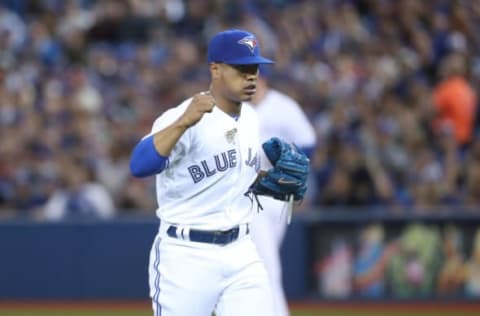
This past week I took a look at the top drafted and developed positional players. Today, I’ll take a look at the top five drafted and developed starting pitchers in franchise history.
If you had not had a chance to read the top positional players click here to have a read and leave a comment.
#5 Marcus Stroman
Going into the 2012 draft the Blue Jays held two first-round picks, the second being at 22 which they used to draft Marcus Stroman. The scouting report on Stroman was although small in stature for a pitcher he was the most major league ready player in the draft. Stroman had also set the Duke University strikeout record and was previously named an All-Star in the Cape Cod League.
In the same year, he was drafted Stroman jumped all the way to AA after making seven appearances in Vancouver (Single-A Short Season). After spending the entire 2013 season in AA, he made seven appearances in AAA Buffalo in 2014 before being called up to Toronto which was less than two years after being drafted.
Stroman wound up pitching in Toronto for six years and posted a 47-45 record and a 3.76 ERA. Despite what appeared to be a long feud with Ross Atkins, Stroman was always a front of the rotation starting pitcher.
He cemented himself with a lot of Blue Jays fans as a hard-working determined player in 2015 when he tore his ACL and experts were saying he would miss the entire season. Stroman promised to be back in time for playoffs and he delivered. Just over six months after the injury he pitched four games down the stretch which helped the Blue Jays clinch their first AL East pennant since 1993.
Stroman was near perfection in those four starts posting a 4-0 record with a 1.67 ERA. He pitched back-to-back season with 200 innings in 2016 and 2017, and in the second of those seasons, he finished eighth in Cy Young Voting and won a Gold Glove.
In his final season in Toronto, Stroman was named to his first All-Star appearance while playing through an enormous amount of trade rumours. Just a few days before the trade deadline in 2019, Atkins would trade Stroman to the New York Mets for their top two pitching prospects in Simeon Woods Richardson and Anthony Kay.
More Articles About Blue Jays All-Time Lists:
manual
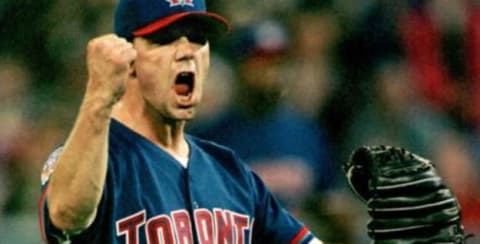
#4 Pat Hentgen
Pat Hentgen might have the best trophy case of any Blue Jay in their history which is pretty impressive for a guy selected in the fifth round. In 1986, despite committing to a scholarship to Western Michigan University, the Blue Jays drafted Hentgen and were able to get him to forgo his education to commit to playing professional baseball.
Like many pitchers drafted out of high school, Hentgen had a slow climb through the minor league system as his first four years were spent at Single-A or below, however he was showing signs of being a star. During the 1988 season, despite still being a teenager the 19-year old Hentgen logged 188 innings winning 11 games while posting a minuscule 2.35 ERA.
After spending his first four years in the lower tiers of the Blue Jays organization he climbed the next two seasons through AA and AA and at the age of 22 he made his first appearance with the Blue Jays in 1991.
During the legendary 1992 season when the Blue Jays won their first World Series, Hentgen pitched in 28 games during the regular season winning five games, unfortunately for him, he was left off the postseason roster. Hentgen’s legend status started to grow in 1993 as he led the rotation in wins (19), ERA (3.87), and WHIP (1.33). He also picked up the win in Game 3 of the World Series after throwing six innings of 1 run baseball.
Hentgen would have eight consecutive seasons of double-digit win seasons, which included his remarkable 1996 season that saw him go 20-10 with a 3.22 ERA. He would lead the league in complete games, shutouts, and innings pitched on his way to the first-ever Cy Young Award by a Blue Jays pitcher. He was named a Blue Jay All-Star three times and finished with a record of 107-85 which ranks him fifth all-time for a Toronto Blue Jay. Hentgen is the only Blue Jays pitcher to win both the Cy Young Award (1996) and World Series (1993) with the Blue Jays.
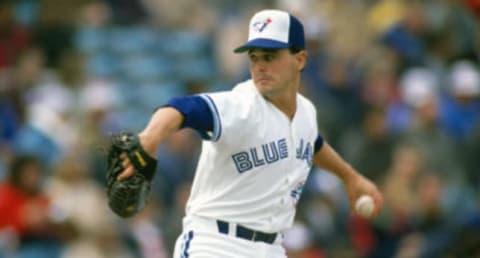
#3 Jimmy Key
In 1982 the Blue Jays were starting to build a real foundation in their organization and had a lot of top-end prospects climbing the system. That draft, in the third round they chose from Clemson University Jimmy Key.
Key had been previously drafted three years earlier out of High School after posting a perfect 10-0 season with a 0.30 ERA however decided to go to school and that worked out well for the Blue Jays. Key was coming into the draft after being named an All-Star for both pitching and as a designated hitter.
Unlike Hentgen who was 17 years old during his first season in the Blue Jays organization, Key was older at 21 when he was drafted and did not need as much time in the minors. Key would pitch in both Rookie Ball and Single-A in his post-draft season and in 1983 which was his first full season of minor league baseball, Key would jump all the way to AAA in Syracuse. Key would pitch in 16 games with the Chiefs to finish out the season and would jump right to the majors the following season.
During his rookie season in 1984, Key would come out of the bullpen for all 63 appearances, however, he would become a starter the following season and the remainder of his career in Toronto. He is commonly referred to as the most underrated Blue Jays pitcher in team history and was arguably robbed of one, maybe two Cy Youngs over his career. Key would win at least 12 games every season as a starter for the Blue Jays and 1987 had his best season that saw him win 17 games. That season he would lead the league in ERA (2.76), WHIP (1.06), and hits per 9 innings (7.2) and finish second in Cy Young voting.
Key finished his Toronto career with a 116-81 record, which has him fourth in All-Time in wins by a Blue Jay and was named an All-Star twice. Key is tied with Dave Stieb for best career ERA (3.42) of any starter and third-best WAR of any pitcher in team history. After winning the World Series in 1992, Key left to the New York Yankees as a free agent.
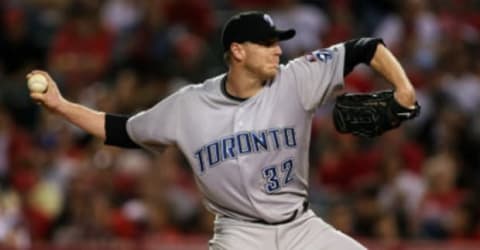
#1B Roy Halladay
The Blue Jays should get bonus points for the development of Roy Halladay, why you may ask. They developed Halladay got him all the way to the majors and then reset the process as he was sent all the way back down to Single-A baseball to re-development himself.
In 1995, Halladay had finished up his High School career and was committed to the University of Arizona, however, after being selected by the Toronto Blue Jays with pick #17 he decided to sign professionally. As high school pitchers go, Halladay climbed the entirely in Rookie Ball with the Gulf Coast League Blue Jays and then went to Dunedin of Advance A ball the following season.
With Dunedin, the 19-year old posted a 15-7 record with a 2.73 ERA and it was evident he needed to be pushed more. In 1997, Halladay pitched in just seven games before the team moved him up to AAA. While his stat line doesn’t look the greatest that year as he posted a 4.77 ERA and 1.49 WHIP, Toronto had a 20-year old pitcher who was one step away from the major leagues and was at least holding his own.
The following season, the team elected to keep him in AAA Syracuse for the season and he impressed to the point the team used one of their September call-ups on Halladay. Halladay got two appearances before the end of the season and the first one has a pretty incredible fact to it.
After pitching five good innings he was taken out. The pitcher that came in relief was Dave Stieb who threw 2.2 shutout innings; this was the only time the two would ever pitch in the same game together.
Halladay made all fans take notice in his second career game when he would take a Perfect Game into the ninth inning. With two outs, pinch hitter Bobby Higginson would take the first pitch he saw over the fence for a home run. The next pitch of the game, Frank Catalanotto would line out to end the game.
After having a successful rookie season in 1999 that was split between AAA and the major leagues, Halladay would struggle mightily in 2000. Halladay struggled all season long, first starting with the team, then being sent down and recalled, but by seasons end he had posted a 10.64 ERA over 67.2 IP.
Halladay would have one of the most successful comeback s of all time and show how much grit and determination he had. The Blue Jays would decide to send Halladay all the way back to Dunedin and revamp the way he throws. Halladay would change his arm delivery angle and work through the Blue Jays system.
This time a little more speedy as he would pitch in Dunedin, Knoxville, Syracuse before finally making his way back to Toronto where he would start 16 games posting a 3.16 ERA and everything else became history after that.
Starting in 2002, Halladay became an All-Star for the first time and follow it up with five more appearances to come. He became the third Blue Jay to claim a Cy Young in 2003 when he led the league in wins, innings pitched, complete games, and shutouts. In 2005, he was leading the way to a second Cy Young Award when just past the midway point of the season he broke his leg on a line drive back to him.
Halladay would finish his Blue Jays career in second place in wins and second in WAR. He is 0.01 behind Jimmy Key and Stieb for ERA among starting pitchers. Although he goes into the Hall of Fame not wearing any team baseball hat, most fans around baseball consider him a Blue Jays Hall of Fame player.
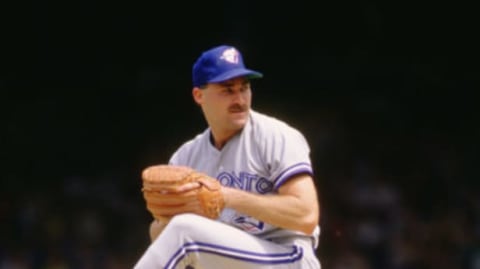
#1A Dave Stieb
After going undrafted in High School, Dave Stieb attended Southern Illinois University and played as an outfielder. After not excelling as a top prospect as a fielder, scouts started to take notice of Stieb as a pitcher when he started coming in relief in games. The Blue Jays took a chance on him and selected him in the fifth round of the 1978 draft and what they got was arguably the best pitcher in team history.
Post Draft, Stieb reported to the Dunedin Blue Jays where he made four starts before the season ended, to say he did well would be an understatement. Stieb posted a 2.08 ERA and 0.923 WHIP and the Blue Jays put more pressure on Stieb the following season. In 1979, Stieb would make just eight more starts for Dunedin and the club jumped him straight up to AAA Syracuse. Once he got to Syracuse he made seven more starts where he had a 5-2 record with a 2.12 ERA and 1.04 WHIP.
Stieb was drafted in June 1978, and on June 29, 1979, he made his major league debut and finished the season in Toronto. By 1980, Stieb had become an All-Star and ace of the Blue Jays pitching rotation. He would pick up at least 11 wins in 10 of his 11 final full seasons in a Toronto uniform. He is arguably a top-five pitcher in the 1980s in all Major League Baseball. He was named an All-Star seven times, received Cy Young Votes five times and AL MVP votes three times. He is the only Blue Jays pitcher to throw a no-hitter and finished his career with 176 wins which is first in team history.
If you look back at the video of the 1992 World Series celebration, Stieb is one of the first players on the field running to the pitchers mound, however, he was not used in the playoffs that year and is not credited with a World Series title. What he does have is the all-time WAR leader among team pitchers, tied with Jimmy Key in ERA, and leads all pitchers in hit batters with 129 which is more than double than the next closest pitcher.
Next. Blue Jays: The All Time Drafted and Developed Team. dark
What order did you have? Is there someone you thought was more deserving? Is Marcus Stroman #5?